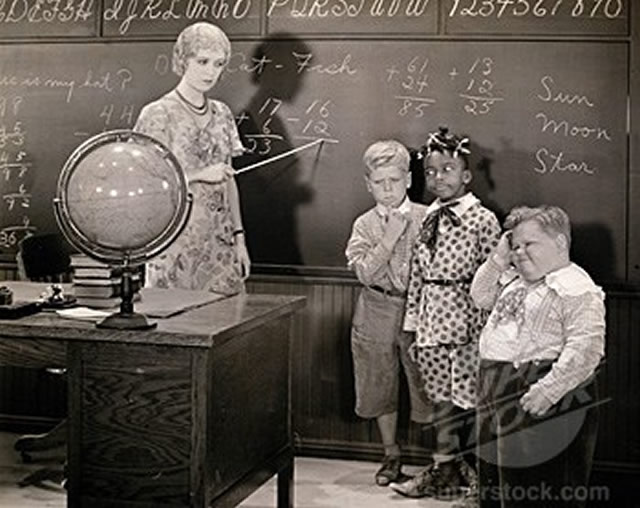
For nearly forty years, the education community has been stumped by the seemingly insurmountable challenge of “getting teachers to use technology.” Generational change, ease-of-use, increasing access, and the remarkable power of computation have been no match for, “I don’t wanna.”
If one doesn’t care to differentiate between the various forms and nutritional value of “educational technology,” it might be easy to celebrate how a lethal global pandemic is “getting teachers to use technology at long last. Just don’t look too closely.
500,000 educators responded heroically to the chaos caused by COVID-19 by joining the Bitmoji Classroom Facebook group. This benefits no one. Coloring rarely results in systemic change. Such nostalgic representations of a teacher standing at the front of the classroom in front of a handwriting chart, holding an apple, with propagandistic slogans, rules, and standards on the “walls” are more than capitulation or timewasting. They are evidence of a failure to seize the moment to create modern, humane, and learner-centered educational experiences – to realize our dreams.
The bitmoji classroom is not just a way for an over-stressed teacher to blow-off steam, or a way to reduce the trauma of students being taught remotely, or communicate with parents. It is a reenactment of Our Gang’s Miss. Crabtree, a desperate self-parody, a Make Schools Great Again hat…
Worst of all, prioritizing classroom décor, real or virtual, is condescending, sexist, and an insult to the intelligence, creativity, and competence of teachers. This infantilizes teachers and resets the system to its default settings, compliance and standardization. Imagine the other things a half million teachers could be doing or learning.
Note: I could go on. There are lots of issues of effective interface design, accessibility high-quality computing experiences, democratic classrooms, and the value/harm of what teachers hang on walls, but I will save those until I am flamed for daring to question the 43 day-old bitmoji classroom tradition.
You might also be interested in yesterday’s article, Stick to Our Knitting.
Veteran educator Gary Stager, Ph.D. is the author of Twenty Things to Do with a Computer – Forward 50, co-author of Invent To Learn — Making, Tinkering, and Engineering in the Classroom, publisher at Constructing Modern Knowledge Press, and the founder of the Constructing Modern Knowledge summer institute. He led professional development in the world’s first 1:1 laptop schools thirty years ago and designed one of the oldest online graduate school programs. Gary is also the curator of The Seymour Papert archives at DailyPapert.com. Learn more about Gary here.

I’ve been asked about 1,287 times in the last few weeks if I can help someone make a Bitmoji classroom. Yes, I can. However, if a person can’t figure that out quickly (five to ten minutes, tops) on his/her own then there are much better things they should spend time doing.
If the argument for making a Bitmoji classroom is “it’s a good way to engage students in online learning” I would argue that a better way to engage kids in online learning is to use sound instructional practices and not worry about the aesthetics. 30 minutes of reading something like Curtis Bonk and Ke Zhang’s Empowering Online Learning is a better use of time than 30 minutes making a Bitmoji classroom.
Gary, I’m a big fan of your work and of progressive education in general (I even attended the very first Constucting Modern Knowledge!) So I uderstand your alarm and dismay at the Bitmoji Classroom fad.
All your points are well taken. That said, I think you need to take a step back. One has to wonder, why the thrist, why the enthusiasm for these Skeumorphic representations of classrooms (nostalgic, reductionist, and cutesy though they may be)? I would guess that perhaps teachers are reacting to the cold, abstract, file-based designs that constitute today’s LMS systems – most notably, Google Classroom. What a teacher sees in a Bitmoji Classroom might be a chance to make a personalized connection with their students. Young kids (the main audience of these designs) love to learn about their teachers, and the spatial representational motiff is a natural, familiar, comforting way to do that. The Bitmoji Classrooms also provide a way for teachers to build their own custom multimedia (to borrow the old 90’s term) designs from scratch. Every other online platform provides just tinkering at the edges of a pre-designed turnkey system. So, while I understand the aesthetic aversion, and the disapointment of the fallback to the instructionalist classroom metaphor, I beleive you also have to understand the justified motivations behind the Bitmoji classrooms, and perhaps highlight the positives as well. In most cases, these teachers are first-time interface designers! While their designs may not meet our standards of progressive education, at least they are designing for themselves, and not just inputing into abstract ready-made templates. As an educator who has had to teach during this pandemic, I’ve learned to recognize and encourage the small victories, and yes, if you look empathetically enough you will find some even in Bitmoji Classrooms.
Great read Gary. I was only to speaking to someone today about this. I also understand the points Peter made in that a lot of teachers (especially at my school) are using it more as a way to foster some sort of connection/ familiarity to school.
All said, they’re all great points. Thanks for sharing.
Thanks!